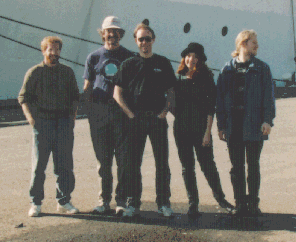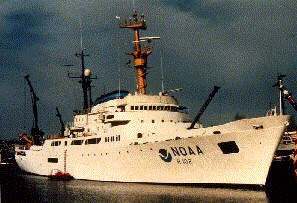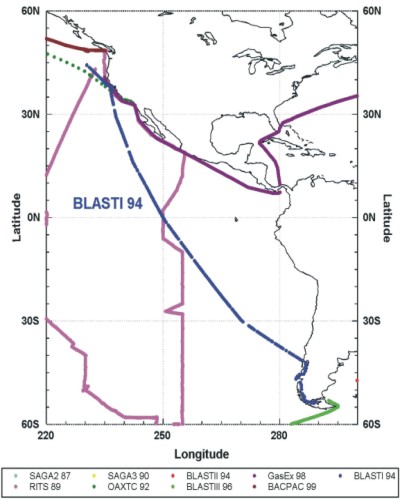B L A S T 94 - Bromine Latitudinal Air/Sea Transect (1994)
Abstract
The goal of this expedition was twofold: first we intended to use a gas chromatograph / mass spectrometer (GC/MS) combination and tried to find out how reliable such an instrument can be out at sea. Secondly, the main purpose then was to measure methyl bromide (CH3Br) in the marine air and the surface waters of the East Pacific Ocean and to determine whether the ocean is a source or a sink for this compound. Along with methyl bromide, we determined about 20 other compounds in both air and surface waters. The expedition started in Seattle, WA, crossed several regions of the East Pacific and reached the inland passage of Chile at 41°S, and finally Punta Arenas, Chile, at 54°S about 4.5 weeks after its beginning.
Surface waters along a cruise track in the East Pacific ocean were undersaturated in methyl bromide (CH3Br) in most areas except for coastal and upwelling regions, with saturation anomalies ranging from +100% in coastal waters to -50% in open ocean areas, representing a regionally weighted mean of -16 (-13 to -20) percent. The partial lifetime of atmospheric CH3Br with respect to calculated oceanic degradation along this cruise track is 3.0 (2.9 to 3.6) years. The global, mean dry mole fraction of CH3Br in the atmosphere was 9.8±0.6 parts per trillion (ppt) with an interhemispheric ratio of 1.31±0.08. These data indicate that ~8 percent (0.2 ppt) of the observed interhemispheric difference in atmospheric CH3Br could be attributed to an uneven global distribution of oceanic sources and sinks.
Methods and list of (the most important) measured compounds:
| Gas chromatograph / mass spectrometer combination: | |
| CFC-12 | CCl2F2 |
| Methyl chloride | CH3Cl |
| CFC-114 | C2Cl2F4 |
| Halon-1211 | CBrClF2 |
| Methyl bromide | CH3Br |
| CFC-11 | CCl3F |
| Methyl iodide | CH3I |
| Methyl chloroform | CH3CCl3 |
| Carbon tetrachloride | CCl4 |
| Dibromomethane | CH2Br2 |
| Perchloroethylene (PCE) | C2Cl4 |
| Bromoform | CHBr3 |
| Gas chromatograph / electron capture detector (surface water): | |
| CFC-12 | CCl2F2 |
| CFC-11 | CCl3F |
| CFC-113 | CCl3CF3 |
| Methyl chloroform | CH3CCl3 |
| Carbon tetrachloride | CCl4 |
| Nitrous Oxide | N2O |
| Sulfur Hexafluoride | SF6 |
Cruise Participants:
- Jürgen M. Lobert (legs 1a and 1b)
Laurie S. Geller (legs 1a and 1b)
Matt R. Nowick (legs 1a and 1b)
James H. Butler (leg 1a)
Steven A. Montzka (leg 1a)

From left to right: Steve, Jim, Jürgen, Laurie, and Matt
The Platform:

The NOAA Ship Discoverer, R 102, is about 93m long, cruises at about 14-16 knots maximum speed, and is staffed with around 50 crew members with a maximum capacity of about 40 scientists. It was one of the largest scientific vessels in the NOAA fleet and operated out of Seattle, Washington until it was retired in 1996. The main laboratory was located on main deck level close to the stern. The portholes of this lab can be seen in this picture left of the ladder from the raft that is tied to the ship.
Cruise Track:

BLAST 94 is shown in blue through the East Pacific Ocean, out of Seattle, Washington into Punta Arenas, Chile.
Publications
- A net sink for atmospheric CH3Br in the East Pacific Ocean,
- BLAST 94: Bromine Latitudinal Air/Sea Transect 1994: Report on oceanic measurements of methyl bromide and other compounds.
- Tropospheric SF6: Observed latitudinal distribution and trends, derived emissions and interhemispheric exchange time,
- Implications of methyl bromide supersaturations in the temperate North Atlantic Ocean, D.B. King, J.H. Butler, S.A. Montzka, S.A. Yvon-Lewis, and J.W. Elkins, J. Geophys. Res., 105, 19,763-19,769 (2000).
J.M. Lobert, J.H. Butler, S.A. Montzka, L.S. Geller, R.C. Myers, and J.W. Elkins,
Science, 267, 1002-1005 (1995). (abstract see above)
J.M. Lobert, J.H. Butler, L.S. Geller, S.A. Yvon, S.A. Montzka, R.C. Myers, A.D. Clarke, and J.W. Elkins.
NOAA Technical Memorandum ERL CMDL-10 (1996).
L.S. Geller, J.W. Elkins, J.M. Lobert, A.D. Clarke, D.F. Hurst, J.H. Butler, and R.C. Myers,
Geophys. Res. Lett., 24, 675-678 (1997).

